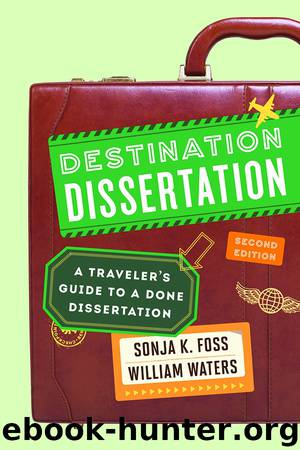Destination Dissertation: A Traveler's Guide to a Done Dissertation by Foss Sonja K. & William Waters

Author:Foss, Sonja K. & William Waters [Foss, Sonja K. & Waters, William]
Language: eng
Format: epub
Publisher: Rowman & Littlefield
Published: 2015-03-14T16:00:00+00:00
G.
Animal Subjects . . . . . . . . . . . . . . . . . . . . . . . . . . . . . . . . . . . . . . . . . . .
29
H.
References Cited . . . . . . . . . . . . . . . . . . . . . . . . . . . . . . . . . . . . . . . . . .
29
A. Specific Aims
Tortuous or twisted blood vessels are associated with cardiovascular diseases such as hypertension, diabetes, and atherosclerosis and could potentially result in myocardial infarction, stroke, or death. However, the underlying mechanisms responsible for tortuosity development remain unclear. Blood vessels are often subject to twist deformations during surgical implantation of vascular grafts; skin grafting procedures; or with movement of the neck, limbs, and torso. Excessive twists may cause blood vessels to lose stability and buckle. Buckling is characterized as the failure of a structure due to mechanical instability and can be the result of various loading conditions including torsion. Once a blood vessel buckles, vascular remodeling may ensue and lead to permanent tortuosity. During the aging process, blood pressure often increases as a result of vessel stiffening, while the in vivo stretch may reduce due to degradation of proteins (i.e., elastin and collagen) within the vessel wall. Accordingly, recent studies by our group have shown that blood vessels buckle when subject to hypertensive pressures or a reduction in axial tension. Yet, little is known regarding the mechanical stability of blood vessels under torsion loading. A severely twisted or kinked blood vessel may increase the risk for further clinical complications such as reduced blood flow and blood clotting and may result in traumatic stent-artery interactions. Thus, it is necessary to understand the buckling behavior of blood vessels under torsion in order to elucidate the pathogenesis of tortuosity and to aid in the development of improved vascular therapies. Furthermore, many studies have shown that stents in mobile arteries such as the carotid, coronary, and superficial femoral arteries are subjected to vessel twisting and have a higher rate of fracture and restenosis, but the mechanisms are poorly understood.
Accordingly, the objective of this study is to determine the buckling behavior of blood vessels under torsion and investigate its effect on stent-artery interactions. The central hypothesis is that torsion can produce buckling in blood vessels and increase wall injury in stented arteries. The hypothesis has been formulated based on preliminary experimental data of torsional bucking analysis performed on porcine common carotid arteries using a torsion machine designed in our laboratory. The rationale for the proposed research is that understanding the buckling behavior of blood vessels under torsion will improve our understanding of tortuosity development and provide guidance for improving the design of vascular stents.
We plan to test the central hypothesis and, thereby, accomplish the
Download
This site does not store any files on its server. We only index and link to content provided by other sites. Please contact the content providers to delete copyright contents if any and email us, we'll remove relevant links or contents immediately.
Navigation and Map Reading by K Andrew(5111)
Spare by Prince Harry The Duke of Sussex(5078)
Tuesdays with Morrie by Mitch Albom(4696)
Cracking the GRE Premium Edition with 6 Practice Tests, 2015 (Graduate School Test Preparation) by Princeton Review(4227)
Machine Learning at Scale with H2O by Gregory Keys | David Whiting(4199)
Never by Ken Follett(3800)
Goodbye Paradise(3729)
What It Really Takes to Get Into Ivy League and Other Highly Selective Colleges by Hughes Chuck(3697)
Harry Potter and the Prisoner of Azkaban (Book 3) by J. K. Rowling(3304)
Fairy Tale by Stephen King(3227)
Pledged by Alexandra Robbins(3138)
Kick Ass in College: Highest Rated "How to Study in College" Book | 77 Ninja Study Skills Tips and Career Strategies | Motivational for College Students: A Guerrilla Guide to College Success by Fox Gunnar(3077)
A Dictionary of Sociology by Unknown(3032)
Sapiens and Homo Deus by Yuval Noah Harari(2990)
Reminders of Him: A Novel by Colleen Hoover(2952)
The Social Psychology of Inequality by Unknown(2941)
Graduate Admissions Essays, Fourth Edition: Write Your Way into the Graduate School of Your Choice (Graduate Admissions Essays: Write Your Way Into the) by Asher Donald(2878)
Will by Will Smith(2795)
Zero to Make by David Lang(2727)
